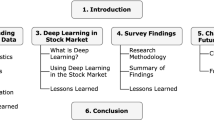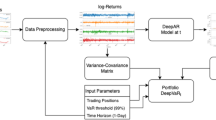Abstract
In this paper, we develop modeling tools to forecast Value-at-Risk and volatility with investment horizons of less than one day. We quantify the market risk based on the study at a 30-min time horizon using modified GARCH models. The evaluation of intraday market risk can be useful to market participants (day traders and market makers) involved in frequent trading. As expected, the volatility features a significant intraday seasonality, which motivates us to include the intraday seasonal indexes in the GARCH models. We also incorporate realized variance (RV) and time-varying degrees of freedom in the GARCH models to capture more intraday information on the volatile market. The intrinsic tail risk index is introduced to assist with understanding the inherent risk level in each trading time interval. The proposed models are evaluated based on their forecasting performance of one-period-ahead volatility and Intraday Value-at-Risk (IVaR) with application to the 30 constituent stocks. We find that models with seasonal indexes generally outperform those without; RV can improve the out-of-sample forecasts of IVaR; student GARCH models with time-varying degrees of freedom perform best at 0.5 and 1 % IVaR, while normal GARCH models excel for 2.5 and 5 % IVaR. The results show that RV and seasonal indexes are useful to forecasting intraday volatility and Intraday VaR.
Similar content being viewed by others
References
Andersen T. G., Bollerslev T. (1998) Answering the skeptics: Yes, standard volatility models do provide accurate forecasts. International Economic Review 39: 4
Andersen T. G., Bollerslev T., Diebold F., Ebens H. (2001a) The distribution of stock return realized volatility. Journal of Financial Economics 61: 43–76
Andersen T. G., Bollerslev T., Diebold F., Labys P. (2001b) The distribution of realized exchange rate volatility. Journal of the American Statistical Association 96: 42–55
Barndorff-Nielsen O. E., Shephard N. (2002) Econometric analysis of realised volatility and its use in estimating stochastic volatility models. Journal of the Royal Statistical Society, Series B 64: 253–280
Beltratti A., Morana C. (1999) Computing Value at Risk with high frequency data. Journal of Empirical Finance 6: 431–455
Brownlees C., Gallo G. (2010) Comparison of volatility measures: A risk management perspective. Journal of Financial Econometrics 8: 29–56
Christodoulakis, G. A., & Satchell, S. E. (1998). Hashing GARCH: A reassessment of volatility forecast and performance. Forecasting Volatility in the Financial Markets, 168–192.
Christoffersen P. F. (1998) Evaluating interval forecasts. International Economic Review 39: 841–862
Coroneo, L., & Veredas, D. (2006). Intradaily seasonality of returns distribution. A quantile regression approach and intradaily VaR estimation. CORE Discussion Papers, 2006077.
Dionne G., Duchesne P., Pacurar M. (2009) Intraday Value at Risk (IVaR) using tick-by-tick data with application to the Toronto stock exchange. Journal of Empirical Finance 16: 777–792
Fleming J., Kirby C., Ostdiek B. (2003) The economic value of volatility timing using realized volatility. Journal of Financial Economics 67: 473–509
Forsberg L., Forsberg L., Forsberg L. (2007) Why do absolute returns predict volatility so well?. Journal of Financial Econometrics 5: 31–67
Fuertes A. M., Izzeldin M., Kalotychou E. (2009) On forecasting daily stock volatility. International Journal of Forecasting 25: 259–281
Hansen P. R., Lunde A. (2005) A forecast comparison of volatility models: Does anything beat a GARCH(1,1)?. Journal of Applied Econometrics 20(7): 873–889
Hansen P. R., Lunde A. (2006) Realized variance and market microstructure noise. Journal of Business and Economic Statistics 24: 127–161
Giot P. (2000) Time transformations, intraday data and volatility models. Journal of Computational Finance 4: 31–62
Giot P. (2005) Market risk models for intraday data. The European Journal of Finance 11: 309–324
Giot P., Laurent S. (2004) Modeling daily Value-at-Risk using realized volatility and arch type models. Journal of Empirical Finance 11: 379–398
Koopman S. J., Jungbacker B., Hol E. (2005) Forecasting daily variability of the S&P 100 stock index using historical, realised and implied volatility measurements. Journal of Empirical Finance 12: 445–475
Lopez J. A. (2001) Evaluating the predictive accuracy of volatility models. Journal of Forecasting 20: 87–109
Martens M. (2001) Forecasting daily exchange return volatility using intraday returns. Journal of International Money and Finance 20: 1–23
Martens M. (2002) Measuring and forecasting S&P 500 index-futures volatility using high-frequency data. Journal of Futures Markets 22: 497–518
So M. K. P., Yu P.L.H. (2006) Empirical analysis of GARCH models in VaR estimation. Journal of International Financial Markets, Institutions and Money 16: 180–197
Takahashi M., Omori Y., Watanabe T. (2009) Estimating stochastic volatility models using daily returns and realized volatility simultaneously. Computational Statistics and Data Analysis 53: 2404–2426
Taylor S. J., Xu X. (1997) The incremental volatility information in one million foreign exchange quotations. Journal of Empirical Finance 4: 317–340
Zhang L., Mykland P., Aït-Sahalia Y. (2005) A tale of two time series: Determining integrated volatility with noisy high-frequency data. Journal of the American Statistical Association 100: 1394–1411
Zhou B. (1996) High-frequency data and volatility in foreign exchange rates. Journal of Business and Economic Statistics 14: 45–52
Author information
Authors and Affiliations
Corresponding author
Rights and permissions
About this article
Cite this article
So, M.K.P., Xu, R. Forecasting Intraday Volatility and Value-at-Risk with High-Frequency Data. Asia-Pac Financ Markets 20, 83–111 (2013). https://doi.org/10.1007/s10690-012-9160-1
Published:
Issue Date:
DOI: https://doi.org/10.1007/s10690-012-9160-1




